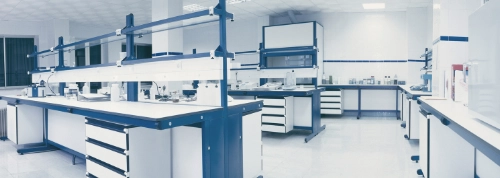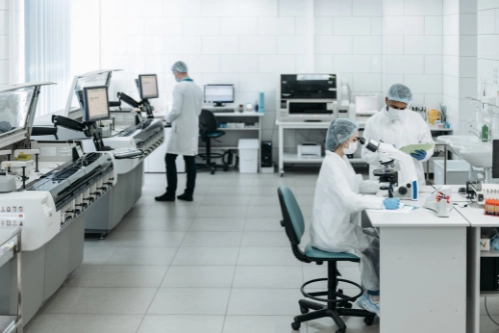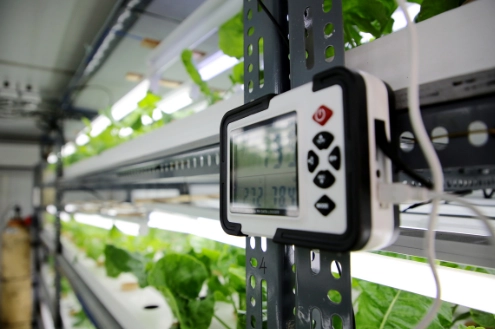
Constant innovation requires an inspiring and calming environment.
Laboratories are crucial environments for research, development, and experimentation. The promotion of worker safety, productivity, and scientific discovery depends heavily on lab design.
It makes sense that the surroundings in which people work in science would similarly be dynamic. Because, in our opinion, laboratory design cannot be approached arbitrarily. Not for those who survive the test of time, at least.
Macbick, one of the leading AI-powered lab design and interiors brands, believes that life science has a promising future and is adaptive. And with lab design evolving alongside the changing requirements of modern scientists, it’s the perfect time to renovate your labs.
The challenge that arises now is to keep up when things are accelerating at such a fast pace.
Don’t worry, as we got you covered. Here are the trends in lab design for 2022–2023 that you need to look out for. From smart laboratories to ergonomic design, these trends guarantee to make sure your company is equipped to prosper in the future and now.
Modularity and Flexibility
A flexible and modular lab design is a cornerstone of modern research facilities. It provides the adaptability required to meet changing research requirements. Mobile workstations, movable shelves, and movable storage are the main components of such designs. These elements make it simple to reconfigure lab areas, encouraging effective use of available space.

For a variety of experimental setups or to accommodate new research initiatives, scientists and researchers can easily rearrange lab supplies, equipment, and benches. By promoting an environment that encourages teamwork and invention, this adaptability not only maximizes the use of the laboratory space but also improves communication amongst scientists.
Overall, laboratories that want to be on the cutting edge of technology development and scientific discovery must have flexible and adaptable lab designs.
Technology Integration
The introduction of technology is essential for boosting laboratory operations’ efficacy and efficiency to previously unheard-of heights. Modern plans for technologically advanced laboratories include a variety of cutting-edge components. These characteristics ensure that scientists always have access to crucial resources, including smoothly integrated power and data communication.
Task lighting is given careful consideration and is precisely incorporated to improve visibility and accuracy during tests. Easy-to-use touch screens also offer quick access to important data and information.
When taken as a whole, these advancements enable scientists and researchers to expedite their work procedures, quicken data analysis, and ultimately make a significant contribution to ground-breaking findings in a variety of scientific fields. This highlights once more the crucial part that technology plays in the contemporary laboratory settings.
Accessibility and ADA Compliance
In order to create a workplace that promotes worker safety and fair access for everyone, accessibility and ADA compliance are crucial. Innovation is important when it comes to building laboratories that are ADA-compliant and accessible.
Exhibiting a promise to inclusivity, the architectural configuration consolidates highlights like customizable level workstations, task lighting, and comfortable seating choices.
All employees, including those with disabilities, have easy access to and use of laboratory equipment thanks to these architectural features.
Associations cultivate an environment where every individual can effectively play out their roles safely and effectively, because of basic changes to workstations and the accessibility of suitable lighting and seating choices.
Eventually, embracing openness and consenting to ADA norms improves wellbeing and cultivates a culture of inclusivity and diversity in the work environment.
Sustainability
Promoting the development of environmentally conscious laboratories is essential, both for environmental preservation and for the improvement of health and safety. The use of eco-friendly processes and materials is at the heart of innovative approaches to creating sustainable laboratory environments. These approaches may include the use of recyclable materials, energy-efficient lighting systems, and low-emission finishes.

Sustainable laboratories can significantly reduce their energy consumption while simultaneously minimizing the release of harmful substances into the environment by seamlessly integrating these elements.
This dual benefit not only reduces the laboratory’s environmental impact but also ensures the safety of all individuals working within its confines. Sustainable lab design is a proactive step toward a healthier, greener future where scientific endeavors may peacefully coexist with environmental protection and everyone’s safety.
Technology Integration

Technology has a huge positive impact on laboratories’ productivity and efficiency. The seamless integration of power and data connections, superior task-oriented lighting, and interactive touch-sensitive panels are cutting-edge ideas for technology-enhanced labs. These sophisticated features provide researchers with quick and effortless access to critical data and knowledge, ultimately amplifying their ability to embark on innovative research pursuits.
Ergonomic Design
The concept of ergonomic design is essential for improving the productivity and wellbeing of workers in the workplace. The seamless adaptation of workstations, seats, and their associated accessories is at the forefront of innovation in ergonomic labs.
These finely crafted elements not only assist in lowering the possible hazards related to musculoskeletal problems but also increase worker comfort in general, which boosts productivity.
Employees may do their duties in such a setting with the utmost efficiency and health, resulting in a seamless integration of workplace safety and improved performance that ultimately serves the interests of both individuals and the company.
Future of Lab Design: Emerging Technologies and Trends
The future of laboratory design embarks upon an unceasing evolution, propelled by emerging technologies and evolving trends. Remarkably, virtual and augmented reality stand poised to revolutionize the manner in which researchers engage with their experiments, presenting immersive encounters that enrich comprehension.

Automation and robotics will assume a pivotal role, streamlining monotonous tasks and mitigating human fallibility, thereby cultivating an environment within the laboratory that is both more efficient and bereft of errors.
Furthermore, the assimilation of intelligent laboratory systems, empowered by the prowess of data analytics and artificial intelligence, shall facilitate the real-time surveillance and scrutiny of experiments, ensuring that decisions are rooted in data-driven wisdom.
This confluence of technology pledges to inaugurate an epoch characterized by heightened efficacy, elevated safety protocols, and augmented productivity, thereby establishing new benchmarks for the laboratories of the future.
Wrapping it Up!
Adopting cutting-edge layout and design principles can actually revolutionize your lab space. You have the power to create an environment that supports efficiency, creativity, and the unrelenting quest of scientific distinction by remaining abreast of the most recent advancements and smoothly integrating them.
One brand stands out above the others when it comes to rearranging and modernizing the aesthetics of your laboratory environment: Macbick. We have raised laboratory design to a completely new level by resolutely committing to infuse goods and services with cutting-edge AI technology.
What sets Macbick apart is their steadfast devotion to harnessing the capabilities of AI in every facet of their operations. From AI-infused products and services to the utilization of AI in research and development, Macbick paves the path in data-informed decision-making. Their extensive integration of AI ensures that each laboratory they engage with evolves into a hub of efficiency, productivity, and innovation.


